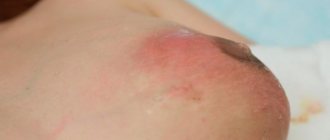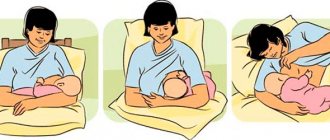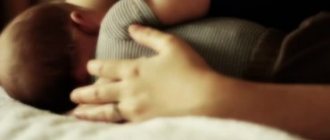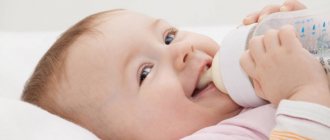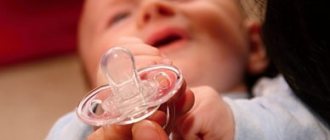Why do my breasts hurt when feeding my baby? Reasons and what to do?
From the moment of birth, a close relationship is established between mother and baby. It becomes even stronger when the mother breastfeeds the baby. However, it happens that in these wonderful moments the young mother feels discomfort and even pain. Why do my breasts hurt when feeding my baby? There may be several reasons for this.
Painful sensations during feeding are caused by the natural adaptation of the mammary glands to the process of lactation. But there may be more serious violations that require appropriate action.
Causes of chest pain during feeding
Natural causes
During pregnancy, a woman's breasts prepare to nourish her newborn. The mammary glands swell, the nipples become darker, and colostrum may be released. With the birth of a child, the restructuring of the body occurs even more intensely. Now the main role is played by prolactin - the “motherhood hormone” and oxytocin - the “love hormone”. Under the influence of these hormones, milk is produced and secreted, replacing colostrum. During this period, many mothers note unpleasant and even painful sensations in the chest. They are associated with the following factors:
- Fast flow of milk. Many mothers describe it as “fullness” or “tingling” in the breasts. Some may even feel pain;
- Getting used to the tender skin of the nipples. It manifests itself in painful sensations when the baby grasps the nipple and the formation of small cracks on it;
- Flushes of milk. The formation of lactation occurs within 3 months from the date of birth of the baby, so “flushes” and “leakage” of milk can persist throughout this entire time. During the flow of milk, pain is felt in the chest, nipple area and lower abdomen. Over time, the young mother develops a reflex when milk comes in at the time of the next feeding. If it is impossible to attach the baby to the breast, you need to express a little milk if the breasts are “bursting.” It’s better to deliver the baby on time.
If the mother frequently and on demand puts the newborn to the breast, making sure that the nipple is properly latched on, these unpleasant sensations will go away. If the chest pain persists and becomes stronger, the reason may be more significant.
See related articles:
But if the discomfort appeared later, then it is necessary to find out why the chest hurts while feeding the baby.
Incorrect nipple latching during feeding
According to the experience of breastfeeding specialists, this is the main cause of lactation disorders. When the baby does not latch onto the nipple correctly, the mother experiences severe pain at the beginning of feeding. You cannot continue to feed the baby, as this affects him negatively: he does not eat enough, and also swallows a lot of excess air - this can lead to excessive gas formation.
It is necessary to ensure that the baby latches onto the breast correctly. To do this, mom can take the following actions:
- Wait until the child opens his mouth wide. He will do this reflexively if you run your nipple across his lower lip;
- Pull the baby's head towards you. The newborn's mouth should seem to be “resting” on the nipple; only a small part of the areola will be visible to you. In this case, the nipple will be at the level of the root of the tongue, which will make it impossible to injure it;
- If the nipple cannot be captured, you need to tighten the skin of the areola, with your thumb at the top and your index finger at the bottom. Having placed the nipple in the baby's mouth, release the breast - it will straighten itself, ensuring a correct latch.
You can achieve the correct latch in any feeding position. Still, the optimal position for this is to hold the baby from under the arm while lying down. Having learned to do this correctly, the baby will not cause pain to the mother during feeding.
It happens that a child cannot latch onto the breast correctly for purely physiological reasons:
- Short bridle. This problem can be solved by contacting a pediatric dentist. He will surgically fix the frenulum in a few minutes;
- Pathology of the upper palate. This disorder is rare and should also be discussed with a dentist.
Correct latching of the nipple by a child
Injury to the skin of the nipples
Due to the inexperience of the young mother and baby, cracks may appear on the nipples. They cause severe pain during feeding. This can happen for the following reasons:
- Incorrect latch when the baby sucks only part of the nipple, without the areola. This can lead to mechanical injuries, resulting in cracks;
- Excessive breast care. Washing your breasts too often removes the protective lubricant and leads to dryness and thinning of the nipple skin;
- Incorrect pumping technique. Sometimes a woman needs to express milk: to improve lactation, when she leaves the baby for a while, gets sick or finishes breastfeeding. In this case, you do not need to squeeze the breast too much or perform manipulations only in the area of the nipple, or put pressure on it. It is better to use a breast pump for expressing, but using it too intensively can also cause cracked nipples;
- Abrupt interruption of feeding. Cracks occur when, in order to complete or interrupt feeding, the mother abruptly pulls the nipple out of the baby's mouth. The baby will relax his mouth and release the nipple when he is satisfied. If it is necessary to abruptly interrupt the process, you should carefully insert a clean little finger into the mouth and remove the breast.
We also read about cracked nipples and how to treat them
Thrush
Cracks and abrasions on the nipples easily become sites for the spread of fungal and staphylococcal infections. In this case, a whitish coating forms on the nipples, as well as the child’s gums, cheeks and tongue. The baby begins to cry and refuse to eat.
It’s painful for mom to feed and express milk, and her breasts hurt between feedings, especially if the infection penetrates deeper and affects the milk ducts. This can occur against the background of changes in hormonal levels, reduced immunity and non-compliance with hygiene rules (rare or excessively frequent breast washing).
The woman needs to see a doctor: he will select the appropriate medications that will successfully cope with the infection and allow you to continue breastfeeding. The doctor will also recommend means to combat the manifestation of thrush in a child.
Lactostasis
Lactostasis is the stagnation of milk in the ducts of the mammary glands. This can be caused by several factors:
- Insufficient and irregular emptying of the breast due to improper attachment, bottle feeding, cracked nipples;
- Holding the mammary gland during feeding: fingers can pinch some ducts, as a result of which they are not completely emptied;
- Tight underwear, sleeping on your stomach;
- Hyperlactation – excessive milk production;
- Stress, lack of sleep, overwork;
- Bruises, injuries, hypothermia of the chest.
With lactostasis, the breasts become hard, lumps are felt on palpation, and the skin may turn red. The temperature of the mammary gland increases, while the body temperature remains normal. It is painful for a mother to breastfeed, and the pain continues after feeding.
Milk stagnation is also not a contraindication to breastfeeding. On the contrary, regular and frequent feeding of the baby to the breast can cope with it within 2-3 days. However, pain may persist even after complete emptying of the mammary glands. Long-term lactostasis can cause uninfected mastitis.
Read in detail about lactostasis and the treatment of lactostasis
Memo. Lactostasis
Mastitis
Inflammation of the mammary gland is called mastitis. It can develop due to stagnation of milk (lactostasis), as well as cracks in the nipples, into which infection penetrates. Mastitis is manifested by severe pain in the chest, lumps, redness, fever, and chills. The risk of mastitis increases due to the weakening of the body after a difficult birth.
Inflammation leads to the formation of an abscess in the mammary gland, and pus may be mixed with breast milk. In such cases, breastfeeding will have to be stopped until recovery. In advanced cases, mastitis can lead to breast deformation, sepsis and death.
Hello girls) I didn’t think that the problem of stretch marks would affect me too, and I’ll also write about it))) But there’s nowhere to go, so I’m writing here: How did I get rid of stretch marks after childbirth? I will be very glad if my method helps you too...
Treatment of mastitis in the initial stages involves applying cold to the breast between feedings (chilled cabbage leaves are useful, for example) and completely emptying the mammary gland (frequent latching of the baby, pumping if necessary). For complex forms of mastitis, antibiotics are used, and in advanced cases, surgery is used.
Read in detail about mastitis and the treatment of mastitis
Vasospasm
Vasospasm (Raynaud's syndrome) is a sharp contraction of the blood vessels of the chest. It was first described by Canadian pediatrician Jack Newman. He suggested that the burning pain after feeding was associated with spasm of blood vessels. It occurs due to a sudden change in temperature when the baby releases the nipple from the mouth. At the same time, the nipple changes its color: from beige to white. Due to vascular spasm, blood access is blocked, this causes pain after feeding, which can also appear between them.
If a nursing woman suffers from vasospasm, she should consult a doctor and be checked for the presence of autoimmune diseases, as vasospasm can develop against their background. In addition, you should keep your breasts warm and cover them immediately after feeding. Do not drink strong tea and coffee - they can cause vascular spasms. To alleviate the condition, chest massage is recommended.
Prevention
To prevent chest pain from occurring, every nursing mother needs to know about preventive measures, as well as respond in a timely manner to the occurrence of unpleasant sensations. The set of preventive measures includes the following tactics:
1. Put your baby to your breast as often as possible. This will ensure sufficient milk production and help cope with excess milk without causing stagnation.
2. Make sure that the baby latches onto the breast correctly, emptying all the ducts of the mammary gland.
3. If pumping is necessary, follow the following technique:
- Before you start pumping, take a warm shower or apply a warm, dry towel.
- Take a warm drink 10 minutes before.
- Massage your breasts, stroking them from the base to the nipple with gentle stroking movements. You can use a soft diaper to avoid skin injury.
- Remember your baby, imagine how he sucks the breast.
4. Maintain hygiene, but without fanaticism. A regular daily shower is enough to cleanse your breasts. To moisturize the skin of the nipples and prevent cracks, you can squeeze out a drop of milk and leave until dry. Breast milk has a wound healing effect.
5. Choose a bra that supports but does not compress your breasts. Special underwear for nursing mothers would be optimal.
6. If cracks and inflammation appear on the nipples, use wound-healing gels between feedings, for example, Bepanten.
7. In case of milk stagnation, use warm compresses before feedings. To relieve pain and improve milk flow, bend over and shake your breasts a little.
8. Choose a sleeping position on your side or back.
9. Protect your chest from bruises, blows, and hypothermia.
10. If it is painful to breastfeed and the pain becomes stronger, it is better to stop breastfeeding, replacing it with formula or expressed milk for 1-2 days, until the symptoms alleviate.
Breastfeeding should bring pleasure and joy to both mother and baby. If something goes wrong in this process, the mother begins to experience discomfort and pain. It is important to find out in time why your breasts hurt during feeding and eliminate the causes. If pain is acute or prolonged, you should consult a doctor.
The World Health Organization recommends breastfeeding for 1-2 years after birth. This will ensure strong immunity, psychological comfort and a close connection between the baby and the mother.
If the pain does not go away for a long time or is accompanied by an increase in temperature, the appearance of space-occupying formations in the chest, or rashes on the skin of the mammary gland, then you should consult a doctor. It will help determine the cause of chest pain.
Important on the topic of GW
...may be of interest...
Video: how to avoid breast problems during feeding
Hello girls! Today I will tell you how I managed to get in shape, lose 20 kilograms, and finally get rid of the terrible complexes of fat people. I hope you find the information useful!
Do you want to be the first to read our materials? Subscribe to our telegram channel
razvitie-krohi.ru
If your breasts are full of milk and hurt
When your milk first starts to come in, your breasts may feel hot, heavy, and hard. You may feel like your breasts are hardened. This occurs partly due to milk filling the breasts, but also due to the increased volume of blood and fluid in the supporting tissue of the gland.
In most cases, the breasts are simply full of milk. The milk continues to flow and the baby can feed normally. To keep your breasts free of milk, you need to feed your baby frequently. If breast fullness does not decrease during feeding, the remaining milk should be expressed. In these first days after childbirth, in order to prevent lactostasis (milk stagnation), it is recommended to limit fluid intake. During this same period, a dairy-vegetable diet is preferable. After a few days, the breasts will not be as full, although they will produce a lot of milk.
Sometimes, especially if the breast is not sufficiently drained of milk, painful engorgement may occur. The breasts become tight and the skin becomes shiny due to swelling. Milk may stop flowing from the breast.
Breast engorgement can occur for the following reasons:
- A tight areola does not allow the baby to stretch the breast sufficiently
- The incorrect position in which the baby sucks does not allow the breast to effectively empty the breast of milk.
- Sucking in the wrong position can cause painful cracked nipples, limiting the frequency of feedings
- When a baby doesn't suckle often enough, the milk in the breast stagnates
- Through a cracked nipple, an infection can enter the breast and cause a breast abscess or mastitis.
To treat breast engorgement, the baby should continue to breastfeed as much as possible. If the baby does not suck milk, you need to express it. The mother can express milk with her hands. If this causes her pain, you can resort to using a breast pump. Once some of the milk has been expressed, the breasts will become softer and your baby will be able to latch on sufficiently and suckle more effectively. You should continue pumping as often as necessary until breast engorgement disappears.
If there is engorgement of the mammary glands, you can apply warm local compresses.
Taking homeopathic remedies can be of great help:
- Mercurius solubilis
- for swelling of the breasts, especially the nipples, which are harder than usual - Calcarea carbonica
- for swelling and heat in the chest, with sore nipples - Belladonna
- for tightness in the breast with strong secretion of milk and partial signs of inflammation - Rhus toxkodendron
- painful stretching of the breast when the release of milk causes itching and pain in the nipples - Zincum metallkum
- stretching of the chest with soreness of the nipples.
Pathological lactostasis
With pathological lactostasis, uniform engorgement and soreness of the mammary glands are observed, which is accompanied by an increase in body temperature to 38-38.5 ° C. General health changes little. These phenomena usually occur from 2 to 6 days after birth. This early breast engorgement is a consequence of increased blood supply and activity of the breast tissue at the time milk production begins. Breast engorgement can also occur if, for some reason, the baby is not fed as often as usual or is not feeding properly.
In this situation:
- feed your baby more often and avoid using a pacifier;
- Before putting the baby to the breast, and also to prevent damage to the nipples, stimulate the milk ejection reflex (see breast massage);
- first express a little milk to soften the breast, this will allow the baby to latch on correctly;
- During feeding, massage your breasts (stroking your breasts towards the nipple)
- After feeding, express milk until your breasts are soft;
- rest and relax;
- apply a warm compress to your chest;
- Wear a bra that holds your breasts well, but is not too tight;
- Once again, pay attention to the sucking technique.
The following homeopathic remedies can be used to treat lactostasis:
Aconite
- at the beginning of the disease, with a pronounced temperature reaction, especially if manifestations of lactostasis are accompanied by physical and/or mental agitation.
Belladonna
- especially indicated for sudden onset and rapid development of symptoms, as well as for tenderness of the mammary glands.
Bryonia
- according to R. Yuz, the best medicine for pathological lactostasis; according to the author, 6 and 12 C dilutions are especially effective.
Calcarea carbonica
- prescribed for strong milk flow.
Pulsatilla
, according to E.G. Ruddock, “an excellent means for establishing the separation of milk.”
All these five medications can be prescribed either alternately, or each independently every 20, 60, 90 minutes, depending on the severity of clinical manifestations.
Homoluxicological drugs can also be used:
Traumeel S
- drops through the mouth (5-7 drops 4-5 times a day);
Belladonna Homaccord
- drops through the mouth (5-7 drops 2 times a day);
Lymphomyosot
- drops through the mouth (5-7 drops 3 times a day).
Locally, you can use Beladonna ointment, ointment and a wet bandage with a solution of Arnica tincture, Traumeel ointment.
Does breastfeeding hurt? 10 myths about breastfeeding
Diana Andrusenko July 9, 2021, 11:29
It shouldn’t be like this if you do everything right. Perhaps at first, while you are just learning to breastfeed, this will be the case, but then it will be the other way around. The main thing is that at first you have a professional next to you who will teach you how to feed properly.
Myth 2: Breastfeeding is painful.
The first few days there may be slight painful sensitivity in the nipples, but then it disappears. If the pain remains, it means you are not putting your baby to the breast correctly. You cannot ignore the pain - if it is not a soft, quiet pain that does not cause discomfort, then be sure to consult a doctor.
Myth 3. Many women do not produce enough milk.
In fact, on the contrary, most people even experience an excess of milk. If a baby is losing weight or not growing enough, the main reason is that the baby is not getting the amount of milk he needs. And this happens because the woman applies it to her breast incorrectly. This is why it is so important that immediately after birth the mother is shown how to feed her baby correctly.
Myth 4. In hot weather, the baby should be given additional water
It is absolutely useless to do this. Breast milk contains all the water a baby needs.
Myth 5. If a baby is breastfed, he needs an extra dose of vitamin D
If the woman herself did not have a deficiency of vitamin D during pregnancy and the postpartum period, then milk will have absolutely enough of it.
Myth 6. Breastfeeding limits a woman
In fact, it's the opposite - it makes her life easier. After all, you can breastfeed anytime, anywhere. You don’t have to worry about sterility, think about where to warm the milk, or carry bottles of artificial nutrition with you.
Myth 7: Breast milk doesn't contain enough iron for your baby.
Believe me, there is just the right amount of it. But artificial nutrition contains more iron than a child can absorb. Therefore, most of it is simply excreted naturally.
Myth 8. If your baby has digestive problems, you should stop breastfeeding.
It is not true. We must stop giving everything else except breast milk. Continue breastfeeding, because your milk is the best medicine for treating intestinal diseases.
Myth 9. If you are taking medications, you cannot breastfeed.
Most medications are safe, because only the slightest part of them penetrates into the milk and does not cause any harm to the baby. Of course, there are a number of drugs that are contraindicated during breastfeeding, but almost all of them have harmless analogues. So medication treatment is by no means a reason to stop breastfeeding.
Myth 10. The baby should be held at the breast for 10 minutes on each side.
The very concept of “holding at the breast” and “feeding” is different. If within 10 minutes the baby actively absorbs food, then he may not take the other breast. Time doesn't matter. The main thing is to attach the baby to the breast correctly. And it doesn’t matter, at least to one breast, at least in turn.
Watch a video on how to properly attach a baby to the breast:
clutch.ua
How to breastfeed your baby correctly?
How to breastfeed your baby correctly? Of course, many pregnant women think about this. But someone is afraid whether it hurts to breastfeed a child, and someone wants to try as quickly as possible, but does not know how to do it correctly and how often.
Of course, all baby mammals (mleko - milk) immediately after birth intuitively suck on their mother's breast and know how to do it. But a person experiences “woe from his mind.” And as a result, women often cannot adapt to breastfeeding. Many people give up after suffering for some time. Breastfeeding is not difficult at all. But, of course, there are some nuances.
Already during childbirth, if everything is going well, ask the doctor to place the newly born newborn on your stomach. It is advisable to do this in the first 20 minutes after birth, even with the umbilical cord still uncut. It’s great if the baby can take your breast. This early breastfeeding has many advantages, including ensuring good milk production in the mother.
Video: Doctor Elena Antsiferova about breastfeeding
Is it painful to breastfeed?
In the maternity hospital, constantly try to put the baby to the breast yourself, consult with the medical staff on how to breastfeed correctly. At first it will hurt your nipples. They will gradually become less sensitive. Watch how the baby takes the nipple. He must take the entire nipple into his mouth and always include part of the areola. Otherwise, he will swallow air (this causes colic) and, in addition, may damage your nipple.
Be patient and gradually you will succeed. Soon the baby will quickly and confidently latch onto the breast and eat with joy and even greed.
In the video about breastfeeding, take a close look at how babies suck, how they should be held correctly at the breast during natural feeding, and how the mother sits.
How to breastfeed a baby correctly?
Most mothers who come to the Newborn Care course boldly declare that they will feed the baby on demand. But this is only true for the newborn period (up to 28 days). There are many mothers who breastfed their baby randomly at 3, 5, and 7 months. Imagine yourself chewing all day!
Difficult? So the baby has not had time to digest the first portion of breast milk and begin to ferment, and then there is a new portion! And then another, and another... Digestion fails. Thus, if you breastfeed too often, the baby will receive a lot of “fore milk”, rich in lactose (milk sugar), and little “back milk”, rich in satiety fats that are good for the brain, liver, skin and hair.
How many times should you breastfeed your baby per day?
- Feeding on demand is called French (“free”).
- Feeding strictly according to a schedule is the German version.
- Semi-free mode - breastfeed during the day, adhering to a certain schedule, plus or minus 15-30 minutes.
For a newborn up to the 28th day of life, free feeding is best. The baby is still weak, it is difficult for him to suck milk from the breast. And the mother’s breasts themselves are not yet developed; milk is produced with difficulty. From the 2nd month you can switch to a semi-free feeding mode and I recommend this during courses for pregnant women.
www.evadoctor.ru
Why do my breasts hurt when feeding my baby (does it hurt to breastfeed) - reasons and what to do?
From the moment the baby is born, an emotional attachment is formed between him and his mother. It can intensify when breastfeeding. At the same time, there are often cases when a woman experiences discomfort after breastfeeding, which may be accompanied by pain. What is this connected with? Experts identify several causes of chest pain during feeding.
The adaptation of the mammary glands to lactation is accompanied by pain. So there is no cause for concern. But we cannot exclude the presence of various diseases that are worth mentioning in order to take action.
Causes of chest pain during feeding
Natural causes
During pregnancy, the breasts undergo preparation to provide adequate nutrition to the newborn baby. You can observe swelling of the mammary gland and darkening of the nipples. The following factors are distinguished:
- Fast flow of milk. Most women in labor report that this process feels similar to breast expansion or a tingling sensation;
- Pain when grasping the nipple, resulting in the formation of cracks;
- Rush of milk. Lactation is formed up to three months after birth, as a result of which we can talk about the persistence of milk leaks at this time. In a little time, the nursing mother will be able to feel the flow of milk to ensure that the baby is nourished. It is worth expressing milk, especially if you feel “bloating” in your breasts. It is best to feed the baby at this time.
If a woman regularly begins to breastfeed her baby, monitoring the correct latch of the nipple, the pain can gradually go away.
If discomfort appears at a later period of time, it is worth analyzing the possible factors for this condition.
Incorrect nipple latching during feeding
Experts consider this reason to be the main reason for lactation disorders. If the nipple girth is incorrect, the mother may feel pain. This can adversely affect the child himself, who swallows excess air.
It is worth making an effort to ensure your baby latch onto the nipple correctly. For this purpose, a woman can do the following:
- Wait for the moment when the baby opens his mouth. The reflex will work if you touch your lower lip with your nipple;
- Raise the child's head so that the mouth is placed on the nipple, which will avoid injury;
- If it is impossible to grasp the nipple, it is worth tightening the skin of the aureole so that the thumb is on top and the index finger is on the bottom. You can place the nipple in the baby’s mouth and lower the breast, which will facilitate a proper latch.
It is optimal to place the child under the arm, lying down on a suitable surface. If you adapt and learn the correct process, no pain will arise.
Circumstances arise when the baby does not clasp the chest in the correct way precisely because of physiology:
- The bridle is not long enough. The problem can be solved by contacting a dentist who specializes in treating children;
- Pathological structure of the upper palate. Whether it really exists is worth checking with a dentist.
Nipple skin injury
Lack of experience when feeding babies can lead to cracks in the nipple. This can cause painful sensations that manifest themselves due to factors:
- Incorrect grip, due to which the baby sucks only part of the nipple without a halo. This can cause mechanical injuries that cause cracks to appear;
- Regular breast washing can strip away the protective lubricant and lead to dry, thin nipple skin;
- Illiterate pumping. From time to time there is a need to express milk: to improve lactation, while the mother is leaving, during illness, or at the end of feeding. Do not squeeze your breast too much or put pressure on the nipple;
- Suddenly interrupted feeding process. Cracks may appear if the nipple is pulled out suddenly. It’s best to wait until the baby relaxes and lets go. If there is a need to interrupt, you need to insert a clean little finger into your mouth and carefully pull out the nipple.
Thrush
A crack or abrasion on the nipple can become a source of infection. You can find a whitish coating on the nipple, skin of the gums, cheeks, and tongue of the baby. He may cry and refuse food.
At this moment, the woman feels pain, including during the break between feedings. They can intensify when the infection goes deeper and the milk ducts are affected. Among the reasons are changed hormonal levels, disturbances in the functioning of the immune system and irregular hygiene (although this aspect also applies to frequent breast washing).
It is best for a woman to make an appointment with a specialist. Moreover, the doctor will be able to give recommendations regarding the use of control methods if the baby has thrush.
Lactostasis
It is called stagnation of milk in the duct of the mammary gland, which is caused by the following factors:
- Incomplete and inconsistent emptying of the breast, which can be caused by poor attachment, bottle feeding and cracked nipples;
- Holding the breast during feeding: fingers squeeze the ducts, which does not contribute to complete emptying;
- A bra that is too tight, pinching the chest, sleeping on the stomach;
- Increased milk production;
- Experiencing stressful situations, regular lack of sleep and chronic fatigue;
- Accidental bruises, injuries, chest hypothermia.
In the presence of lactostasis, a tightness is felt in the chest, and redness of the skin is observed. Increased breast temperature may be present.
Milk stagnation is not a reason to stop breastfeeding. You can put the baby to your breast for two to three days, which will help you cope with this diagnosis. At the same time, pain may be felt after the breast has emptied. If left untreated, this disease can lead to mastitis, which is not an infection.
Mastitis
It is called inflammation of the mammary gland due to stagnation of milk, cracks in the nipples, which serve as a favorable focus for the penetration of various types of infections. As a result of the diagnosis, severe pain, lumps, red skin, elevated body temperature and chills are felt.
Inflammation may be accompanied by the formation of a harmful process in the mammary glands, as a result of which pus enters the breast milk. The best option in this case is to stop breastfeeding until cured.
At the initial stage, treatment for mastitis may involve applying a cold compress to the breasts between feedings and emptying the mammary glands (feeding the baby frequently or expressing milk). Particularly difficult cases require the use of medications, and in advanced situations, it is worth contacting a surgeon.
Vasospasm
It is a sharp contraction of the blood vessels in the chest. The nipple can change color from beige to white. This process leads to blockage of blood flow, which can cause pain.
If a woman who is breastfeeding experiences pain due to spasm of blood vessels, she should make an appointment with a specialist. In addition, it is necessary to check for the presence of diseases of the immune system. Moreover, it is necessary to keep the breast warm and cover it with a cloth after feeding. Avoid strong tea and coffee. You can resort to chest massage, which will alleviate the woman’s condition.
Preventing breast pain during feeding
They involve not only a timely response to the occurrence of discomfort, but also the following measures:
- Regular application of the baby to the breast, which will promote milk production, will avoid excess milk and will prevent stagnation.
- Monitoring the baby’s correct grasp of the nipple, which will allow the mammary gland ducts to be completely emptied;
- If there is a need to express milk, you should resort to the following actions:
- Before starting the process, you should take a warm shower or take a warm, dry towel;
- Ten minutes before the procedure, drink warm liquid;
- Provide yourself with a breast massage, stroking from the base to the nipple with a gentle movement. You can use a soft cloth to avoid injury to the skin;
- You can remember your child by imagining him suckling;
- Maintain regular hygiene, for which you can only use a regular daily shower. To moisturize the nipples and avoid cracks, squeeze out a drop of milk, leaving it until it dries. Breast milk promotes wound healing.
- Selecting a bra that provides adequate support without squeezing your breasts. It is best to choose specially designed underwear for women who are breastfeeding.
- If cracks and inflammation appear on the nipples, you can use a gel that will ensure wound healing in between feedings.
- If your milk is stagnant, you should resort to using a warm compress. To relieve pain and improve milk flow, you need to bend over and shake your breasts slightly.
- Sleep on your side or back.
- Ensure the safety of the chest, do not expose it to the risk of bruises, blows and the consequences of hypothermia.
- If there is pain during feeding, it is worth ensuring that you stop feeding this way by turning to formula or milk that has been expressed. As soon as symptoms improve, you can return to your previous feeding method.
In conclusion, I would like to say that breastfeeding should not be accompanied by painful sensations experienced by both the baby and the mother. It is best to diagnose the possible causes of this phenomenon, which a qualified doctor can handle.
Experts in the field of pediatrics give recommendations, the essence of which is the need to breastfeed a child for 1-2 years after birth. This will ensure excellent functioning of the immune system and will allow you to form an emotional attachment in your relationship with your baby.
How to prepare your breasts for feeding? (video)
babymir.net
How to help a nursing woman with abdominal pain during lactation
First aid in the event of such a condition depends on whether the patient clearly understands the cause of the development of the pain syndrome. If a woman has a stomach ache during breastfeeding, it is necessary to clearly localize the location of the pain. When pain is noted in the upper half of the abdomen and in the epigastric region, such symptoms are most often caused by an exacerbation of gastritis.
It is important to understand what caused the unpleasant sensations. Most often, this can be caused by poor diet or eating poor quality food. Pain in the abdomen of a girdle nature indicates a disruption of the pancreas.
What can a nursing mother use for such conditions? It should be remembered that most medications can be harmful to the baby, so the choice of medications is quite limited:
- If pain occurs in the stomach area, the drug of choice is Smecta. This medicine is approved for use during lactation and relieves heartburn well and removes harmful substances from a woman’s body. It is possible to use drugs “Omeprazole” or “Almagel A”. With the help of these dosage forms, the feeling of heaviness in the stomach is relieved and pain is relieved.
- In case of disturbances in the functioning of the pancreas, which, in addition to nagging pain, is also characterized by dyspeptic symptoms, it is recommended to take enzymes, in particular “Pancreatin”. However, no more than 1 - 3 tablets are allowed, since enzymes can cause bowel problems in the baby
- If your stomach hurts during breastfeeding, and this is accompanied by excessive gas formation, experts advise using regular dill water, castor oil or Espumisan for treatment. Also, the drug Regulax, which practically does not pass into breast milk, can have a good effect.
- If the reason lies in constipation, then you can use regular glycerin suppositories for children or increase the amount of kefir and yogurt in the diet. Also, do not forget about fruits and liquid soups.
Often, many women try to solve this problem with the help of painkillers. This cannot be done for two reasons. Firstly, most anesthetics dissolve well in human milk, which can affect the baby’s health. In addition, the use of analgin, no-shpa, baralgin can change the picture of the disease, and it will be difficult for specialists to determine the true cause of the mother’s pain symptom.
When your stomach hurts after breastfeeding, you should not self-medicate. Any change in the mother’s condition always affects her child. And even if a woman clearly knows the cause of the development of pain, consulting a specialist in this case will help avoid many complications.

